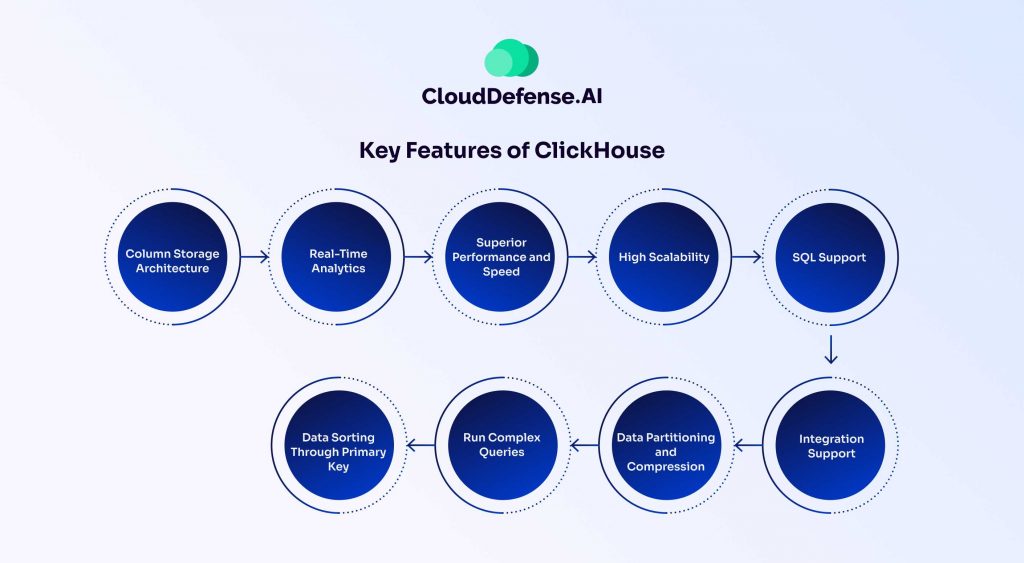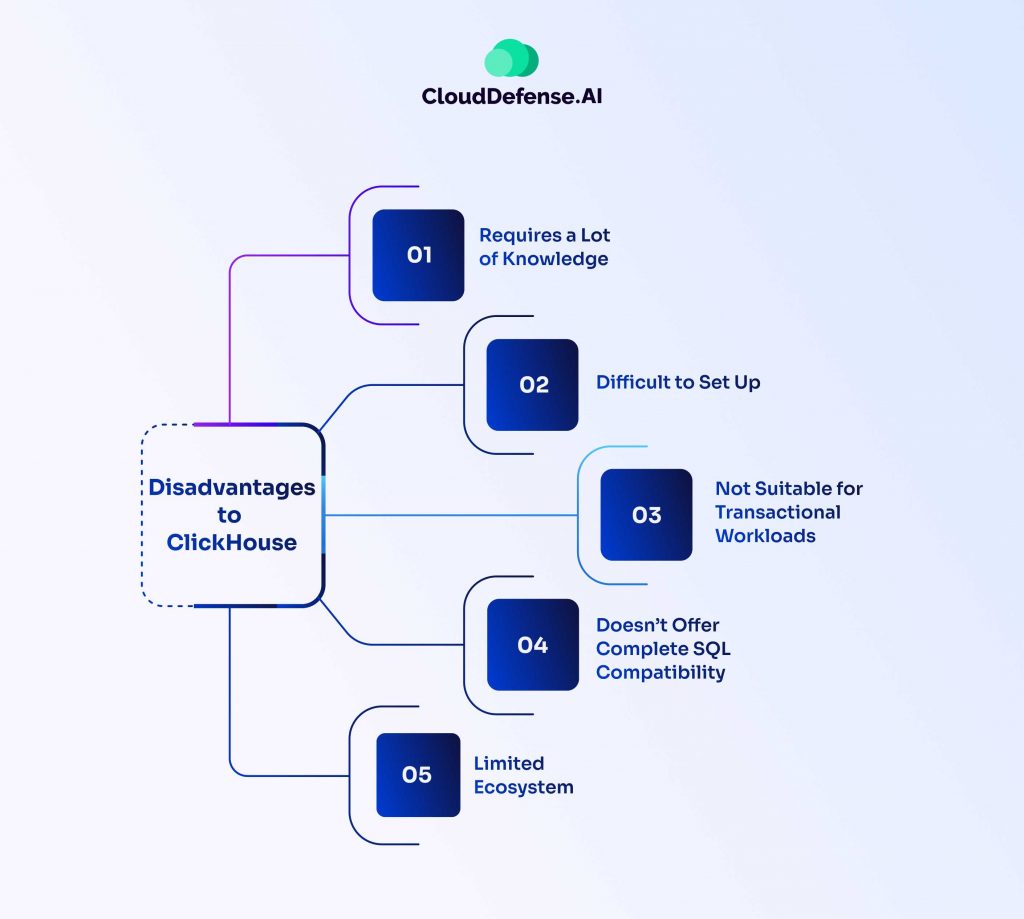In the modern data-driven industry, every organization seeks to enhance their analytical processing and speed of application or product based on a large data set. However, we understand the struggle of finding the right database management system that will help your product or solution with high-performance query processing.
To help you out, today we want to introduce you to ClickHouse. It is a highly scalable open-source database management system offering column orientation. It is designed for online analytical processing and works with applications having massive data sets.
Apart from superfast data storage and processing, it has the capability to return analytics reports of large sets of data in real-time. In this detailed post, we will dig deep into ClickHouse and discuss the following:
- What is ClickHouse?
- Key features of ClickHouse.
- Understanding ClickHouse Architecture.
- Usage and disadvantages of ClickHouse, and
- Column-Oriented Systems and ClickHouse for OLAP Workloads.
Let’s get started!
What is ClickHouse?
Developed by Yandex in 2009, a Russian tech giant, ClickHouse is an open-source SQL-based database management system that allows businesses to generate analytical reports of data quickly. It is a widely popular column-based DBMS (database management system) that not only offers superior performance and high scalability but also processes and generates analytical reports of data in real-time.
It is often considered a columnar DBMS that helps store data in columns and enables the system to retrieve only the exact column without requiring processing the complete row. This is the reason ClickHouse can rapidly work on massive volumes of datasets and quickly return outputs of complex queries.
The columnar storage architecture of ClickHouse also facilitates a higher compression rate and provides horizontal scalability that allows your business to include more nodes to cluster according to data storage requirements.
Even though this SQL data warehouse was introduced in 2009, it was in the year 2016 Yandex made it open-source to the public under the Apache 2 license. Over the years, it has gained massive adoption among top organizations because it follows a community-driven development approach.
Key Features of ClickHouse

ClickHouse is a powerful data processing engine that has many key features that make it stand out from other analytical databases. Let’s dive into the critical feature that enhances data processing and analysis:
Column Storage Architecture
The column storage architecture of ClickHouse is what makes it stand apart from others, as it enables independent storage of data at each column. Due to this, systems are able to execute complex queries quickly as they have to process a small set of columns. The column storage format also offers efficient storage usage and better data compression.
Real-Time Analytics
ClickHouse offers organizations real-time data processing capabilities on streaming data and helps you generate instant query results. It leverages complete CPU and RAM power in the server cluster and analyzes an extensive data set to provide you with quick insight.
Through real-time analytics, it enables you to make decisions according to evolving market trends. Moreover, the fast data processing enables it to work efficiently in a low-latency environment.
Superior Performance and Speed
One of the key features of ClickHouse is its superior speed and performance, which is mainly due to its compression technique, columnar storage, and asynchronous multi-master replication.
It can process massive data sets to provide you with superfast results and derive quick insight for business decisions. It also supports approximate calculation and utilizes unique index designs, which helps deliver quicker results.
High Scalability
Another critical feature of ClickHouse is its scalability, which is facilitated by its support for data replication and partitioning capability. It can scale horizontally with ease and allows you to add more servers to the primary cluster, which ultimately helps you to handle large workloads as your data scales.
SQL Support
The support for SQL makes ClickHouse extremely easy to use, mainly for DevOps and data engineers, as they are familiar with it. The support for SQL makes it easy for new users as they won’t have to go through a steep learning curve.
Integration Support
An impressive feature of ClickHouse is that it can integrate with different ETL frameworks, visualization systems, and data pipelines. Importantly, it helps you create a data processing pipeline while integrating ClickHouse with the organization’s data infrastructure.
Data Partitioning and Compression
ClickHouse offers you a data partitioning and compression facility to ease up data access and storage. It utilizes a powerful compression algorithm and compresses data for easier storage. Partitioning helps the database management system with seamless data access because different nodes in the cluster can access data in parallel.
Run Complex Queries
The support for SQL enables ClickHouse to run complex queries, which ultimately helps in building specific business reports.
Generating complicated data analytics won’t be an issue for you because it offers window functions, grouping, sub-queries, and aggregation. Moreover, you won’t have a problem creating a table inside a cell because it also provides support for the nested data structure.
Data Sorting Through Primary Key
Another crucial feature of ClickHouse is that it sorts all the data using a primary key, and this feature helps it return query results within split seconds. Secondly, it also utilizes data skipping indices, which helps ClickHouse omit the data that doesn’t match the criteria and would be skipped.
Understanding ClickHouse Architecture
The ClickHouse architecture is a highly reliable and high-performance system that has many components that work together to deliver the result. It is based on distributed query execution, columnar data processing engine, merge-tree-based replication, and various familiar design patterns.
The main task of a data processing engine is to save data in a different set of columns, which is then processed by using vector calculation. Due to this calculation, the cost of data processing reduces the overall operation cost and helps ClickHouse integrate seamlessly with different types of servers.
The replication capability also forms an important part of the architecture that not only improves load balancing but also enables distributed query implementation. Importantly, it ensures that the data is always available for the application, even when any of the nodes fails.
ClickHouse is built with a query processor that supports optimizing and parsing all the input queries before they are finally executed. It is also responsible for helping ClickHouse reduce processing time and data reads.
The interface serves as a key part of ClickHouse architecture as it serves as the main medium through which every user interacts with the DBMS. Since it supports SQL, it gets SQL clients, and in some cases, it gets APIs.
ZooKeeper is another important aspect of ClickHouse, which is basically a distributed coordination service. It helps in synchronizing data replication between nodes in the existing cluster and also helps in cluster metadata management.
When to Use ClickHouse
ClickHouse is a highly useful DBMS solution that is really useful for analyzing massive database sets. It serves as an obvious choice for OLAP applications, but ClickHouse is not limited to only these functions. Let’s check out when ClickHouse can be useful for your organization:
- Quick Results and Efficient Storage: ClickHouse should be used when your organization needs quick query results and efficient storage from a large data set.
- Getting Market Trends: You can utilize this DBMS when you want to analyze time-stamped data properly to get deep insight into market trends or user behavior.
- System and Application Insight: This open-source solution comes in really handy when you want to achieve accurate insights from systems, servers, and applications.
- Analyzing Data: When you want to analyze a large pool of streaming data, ClickHouse will be useful for you because it will return quick results and help you make effective business decisions.
- Quick Data Exploration: ClickHouse helps in faster data exploration by enabling organizations with SQL support and quick query execution.
- Monitoring User Behavior: This DBMS can be utilized to gain insights from user behavior in the application or website and make changes to the business process to offer better results.
- Analyzing Large Dataset: You can utilize ClickHouse when you have to deal with datasets with huge numbers of columns, and the column values are quite small.
- Real-Time Processing: ClickHouse would serve as an appropriate choice when your system requires real-time data processing to help in the machine learning workflow.
- Detailed Analytics: This column-based BI tool is highly useful when you want to get advanced analytics and reports by analyzing a large set of structured data.
- Solving Aggregation: You can leverage ClickHouse when your data is properly structured, but they are aggregated.
- Running Complex Queries: ClickHouse is suitable for complex queries where you don’t want to modify the data or get specific rows.
Column-Oriented Systems and ClickHouse for OLAP Workload
Column-oriented systems are perfectly suitable for OLAP workloads because they offer them numerous benefits. Column-oriented systems like ClickHouse not only can generate analytics quickly on massive datasets and compress data but also help you with data aggregation.
This robust DBMS is widely preferred by organizations because it can provide you with real-time insights into the workflow by processing and analyzing large datasets in a short time-period.
Column-oriented database management systems like ClickHouse store all the data in a certain column rather than and that too in an adjacent block of memory. The storage of data in columns helps in analyzing large data and quicker queries; making them ideal for OLAP workloads.
Data compression is another important aspect that makes ClickHouse highly favorable for OLAP workloads. Column-based systems like this can easily compress data due to the large number of repetitions in the columns that allow for a higher compression rate. Since compressed data takes up a low amount of space in the server, this helps ClickHouse for quicker querying, analysis, and data transfer.
The columnar-based architecture of tools like ClickHouse is widely used by organizations because it offers numerous features that work best on OLAP workloads. The support for cube operation and inbuilt functions like COUNT and SUM make it easy for organizations to work on OLAP workloads and gain faster results.
Another reason ClickHouse is widely preferred for OLAP workloads is that they can not only provide faster analytics on a massive pool of data but also help in doing aggregations.
Unlike row-oriented systems, column-oriented tools like ClickHouse can only go through particular columns rather than scanning an entire row when there is a specific query and genre quicker output. The specific scanning of columns helps reduce disk I/O requirements and enhances overall performance.
Disadvantages to ClickHouse

Like every other column-based system, ClickHouse has many disadvantages. It is vital to understand its shortcomings and disadvantages so that it is easier for you to know how you can utilize it properly:
Requires a Lot of Knowledge
Even though data engineers find it easy to work on ClickHouse due to its SQL format, it can be tough for new users who are not familiar with columnar database systems.
Moreover, using its advanced features and properly utilizing them will require huge expertise; thus, employees have to go through a steep learning curve. To utilize custom functions, employees need to have a deep understanding of them to use them to their full potential.
Difficult to Set Up
A huge drawback of ClickHouse is that it can be difficult to set up, especially for employees who are not familiar with the database management system. Employees need to have technical expertise to properly configure the cluster and handle advanced features during the setup process.
Not Suitable for Transactional Workloads
Column-based systems like ClickHouse are primarily suitable for analytical or OLAP workloads, and they don’t offer much support for transactional workloads. So, if you are using an application or website that performs a lot of read-and-write operations, then ClickHouse won’t be a good choice for your organization.
Doesn’t Offer Complete SQL Compatibility
ClickHouse may get an SQL interface, but it doesn’t have compatibility with all SQL syntax and features from other databases. It might be difficult for employees to work on certain advanced SQL functions because they will require tweaking for compatibility.
Limited Ecosystem
ClickHouse is garnering a lot of attention with its capabilities and superior performance, but it still has limitations when it comes to its ecosystem. Unlike other databases, it only offers a limited number of libraries, extensions, and tools to its users. Importantly, it doesn’t have the same level of adoption as other established databases, and this has led to fewer tools and integrations.
FAQ
Is Clickhouse hard to set up?
ClickHouse may be a wonderful BI tool, but it has a complex setup process. It can be daunting to set up for employees who are not familiar with database management systems and server administration.
Moreover, ClickHouse requires a lot of configuration during the setup, which might be difficult for employees who don’t have a deep understanding of database setup.
Who uses ClickHouse?
Organizations that are based on OLAP workloads widely use ClickHouse for real-time analytics and business intelligence.
It has a massive popularity among top IT organizations that include Microsoft, Tesla, eBay, Uber, Disney+, Cisco, Walmart Inc, Bloomberg, Avast, Tencent, and many others. Organizations from automation, software & technology, maps, analytics, SEO, e-commerce, SaaS, travel, etc, utilize ClickHouse.
Is ClickHouse suitable for online transaction processing (OLTP) systems?
ClickHouse is not designed to work with online transaction processing systems as it is mostly suitable for real-time analytical queries and data processing on large data sets.
If you use them on websites that perform frequent read and write operations, it won’t offer an effective result. It only excels in analytical use cases, while databases like MySQL are compatible with OLTP systems for transaction processing and data consistency.
What language does ClickHouse use for queries?
ClickHouse supports declarative query language, which is similar to the ANSI SQL standard. It is basically an extended SQL-like language encompassing approximate functions, nested data structures, and arrays.
Conclusion
We know finding the appropriate database management system for your OLAP workloads can be tricky. However, ClickHouse solves this issue as it comes as the ideal choice for applications or websites requiring real-time data analytics and processing.
This high-performance and easy-to-use solution enables your organization to gain actionable insight from a large pool of data and utilize it to make vital business decisions. In this article, we have discussed ClickHouse in every detail, helping you understand how you can utilize it in today’s data-driven world.







